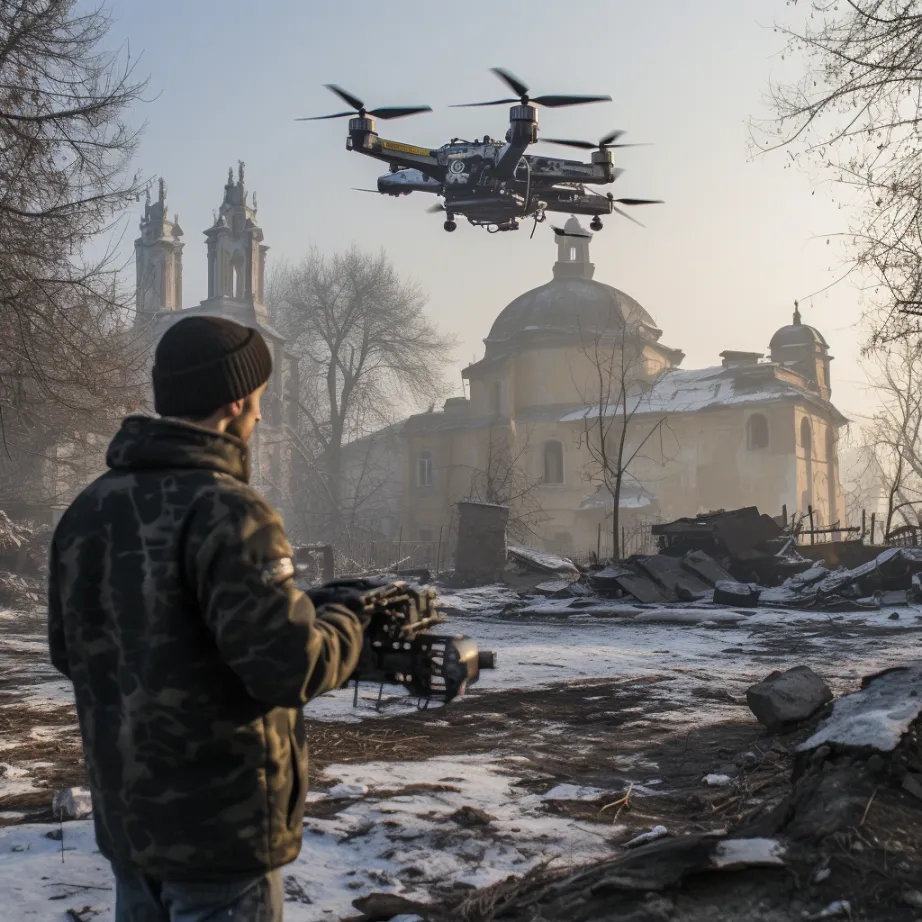Drones enhance defences in the Ukraine war

Before the war in Ukraine, the prevailing belief about drones was that they would make it easier for less wealthy entities to acquire advanced aerial military capabilities because of their low cost and reliance on dual-use technologies. This concept was often referred to as the ‘Poor Man’s Air Force’. Such a development could have facilitated offensive military operations, leading to instability and conflict. Concerns about the drones’ potential impact on international security led many to call for limits and regulations on their sale.
These arguments seemed to receive substantial empirical support in 2020. The Turkish military successfully used drone-based airpower to cripple the Syrian Arab Army in Northern Syria. They also deployed Bayraktar TB2 drones to Libya, helping to check Libyan opposition advances. Azerbaijan’s war in Nagorno-Karabakh later that same year substantially rested on combat drones after Armenian air defences had been neutralised. Combat drones, particularly the TB2s, were the subject of a ‘hype wave’. A flurry of popular science articles announced a revolution in military affairs triggered by Baykar Industries.
Seeing and striking
However, few predicted that drones would enhance defensive operations, rather than offensive ones. This new facet of drone use is evidenced in the war in Ukraine, where growing drone capabilities have led the two sides into a stalemate. In an Economist interview in November, the Ukrainian military commander-in-chief, General Valery Zaluzhny, recalled reading a Russian general’s 1941 treatise on ‘Breaching Fortified Defence Lines’: “I realised that is exactly where we are [now] because just like then, the level of our technological development today has put both us and our enemies in a stupor.”
In particular, Zaluzhny focused on the quality and quantity of modern (military and, increasingly, civilian) sensors, which enable forces to quickly detect, identify, and geolocate enemy troops and conduct precision strikes. “The simple fact is that we see everything the enemy is doing and they see everything we are doing”, noted Zaluzhny.
On the battlefield, the first protective measure against enemy fire is not to be seen at all – that is, to avoid detection by advanced sensors like thermal and infrared cameras as well as radars. This is why remaining mobile, minimising detectable emissions, and actively concealing friendly assets are of such importance. Still, the war in Ukraine demonstrates that the effectiveness of such measures is decreasing (but not vanishing) because of the widespread use of sensors and the ever-improving means of combining data from various sensors into a coherent operational picture.
If avoiding detection is not possible, the other options are either deceiving the enemy or enhancing the durability of equipment and personnel. This is why air defence and counter-drone systems are necessary to disrupt hostile reconnaissance and strike systems. In other words, a formation can only advance relatively securely if it is accompanied by defensive systems that can keep pace with its movement.
The initial phase of the Russian invasion in 2022 demonstrated what happened to forces that did not operate with such protection. Ukrainian medium-altitude long-endurance (MALE) drones, like the TB2, picked off Russian forces that had rushed ahead of their mobile protective systems—driven by optimistic war plans that underestimated Ukrainian resistance.
Defence-enhancing drones
Ukrainian forces had effectively integrated reconnaissance drones into the artillery to identify and destroy Russian armoured columns. Man-portable anti-tank weapons, such as Javelin and Next generation Light Anti-tank Weapon (NLAW), mostly served to impede and direct these columns into killing zones where precision artillery destroyed the majority of vehicles. However, the era of medium-altitude drones faded with the conclusion of the Battle of Kyiv, when the frontlines consolidated in the spring of 2022. Since then, MALE drones have largely disappeared from the news because of their vulnerability to modern air defence systems. Instead, smaller, lower-flying drones have assumed more significant roles by dramatically increasing situational awareness for troops on the front line—in particular because they do not follow the rules of traditional airpower and air defence.
According to an article on the ‘inside unmanned systems’ website, “drone intelligence, surveillance and reconnaissance, wedded to effective precision fires, could render the mechanised breaching tactics developed in World War II insupportably costly. Massed armor was simply too easy to detect and rapidly strike.” This means that deployment of large forces with sufficient ‘mass’ for breakthrough operations may become increasingly prohibitive, especially when ‘new’ drones—which eliminate tactical surprise—interact with ‘old’ methods such as extensive minefields. These methods force attackers to follow specific routes and slow them down, exposing them to ground and airborne attacks. Ukraine initially attempted such concentrated mechanised breaching operations in June 2023 but soon shifted to small, dismounted units. However, these offensive operations are slow and grinding, which General Zaluzhny highlighted in The Economist.
In this trench warfare-type configuration, drones have significantly strengthened defensive capabilities and reinforced the static nature of the war.
Commercial quadcopter platforms as well as small fixed-wing drones provide persistent surveillance, offering early warning and accurate geolocation of enemy movements. These may be targeted by traditional artillery and mortars, or, increasingly infamously, loitering munitions, often referred to as ‘kamikaze’ drones. One advantage of such attack drones, operated by one person or a small team, is that they can be directed at low tactical levels, allowing for precise firepower without the need for forward observers or communication with higher echelons that direct artillery strikes. The use of Lancet drones by Russian troops to hunt down artillery pieces behind the front line further confirms their usefulness in the modern battlefield.
Lessons from Ukraine
These observations support an argument in contemporary strategic studies that suggests that manoeuvre warfare—the attempt to gain military advantages by rapid movement and surprise—may no longer be viable due to changes in technology. Anthony King and Amos Fox point out that the widespread use of sensors tied to precision weapons of various ranges renders swift advances into enemy territory increasingly unrealistic. Such advances may now at least require a high degree of enemy attrition and displacement.
This discussion does not mean that technology alone determines battle outcomes, or that it is impossible to overcome the defensive fusion of modern surveillance drones and loitering munitions with ‘old’ artillery, anti-personnel mines, and anti-tank mines. We mean that there is now a proof of concept regarding the effective integration of diverse technologies, which has substantially increased the cost and difficulty of offensive operations—at least as far as the present war in Ukraine is concerned. This integration challenges existing tactics, techniques, and procedures. Armed forces will need to devise new operational and tactical approaches to overcome this novel fusion of established methods and cutting-edge technologies, as purely technological solutions are unlikely to be found.





